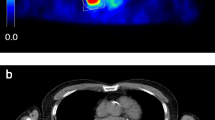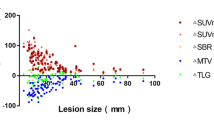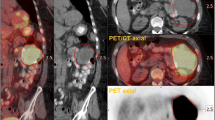Abstract
We propose a new method for diagnostic assistance in oncology, [fluorine-18]-2-fluoro-2-deoxy-d-glucose (FDG)-positron emission tomography (PET). Early and delayed scans were performed on 10 patients with lung cancer by use of an ECAT EXACT 47 PET scanner, and standardized-uptake-value (SUV) images were created. Three segmentation (S1, S2, and S3) maps were created from the early and delayed SUV images according to various thresholds (SUVthreshold = 2.0, 2.5, and 3.0) based on the early image and the percentage change defined as (SUVdelayed − SUVearly) × 100/SUVearly. Voxels that had larger voxel values in their early images than the SUVthreshold were clustered into three classes: S1 if the percentage change was larger than 10, S2 if the percentage change was between 0 and 10, and S3 if the percentage change was negative. The S1 segments showed malignant lesions clearly; however, the S2 segments showed an SUV that had decreased from the S1 areas due to the partial volume effect or misalignment between the early and delayed scans. The S3 areas showed benignity or physiologic accumulation. The segmented images, S1, S2, and S3, were useful for clinical diagnosis with dual-phase FDG-PET scans and offer an easy way of exploring the longitudinal alteration in the SUV.



Similar content being viewed by others
References
Strauss LG, Conti PS. The applications of PET in clinical oncology. J Nucl Med. 1991;32:623–48.
Conti PS, Lilien DL, Hawley K, Keppler J, Grafton ST, Bading JR. PET and [18F]-FDG in oncology: a clinical update. Nucl Med Biol. 1996;23:717–35.
Nolop KB, Rhodes CG, Brudin LH, Beaney RP, Krausz T, Jones T, et al. Glucose utilization in vivo by human pulmonary neoplasms. Cancer. 1987;60:2682–9.
Kubota K, Matsuzawa T, Fujiwara T, Ito M, Hatazawa J, Ishiwata K, et al. Differential diagnosis of lung tumor with positron emission tomography: a prospective study. J Nucl Med. 1990;31:1927–32.
Patz EF Jr, Lowe VJ, Hoffman JM, Paine SS, Burrowes P, Coleman RE, et al. Focal pulmonary abnormalities: evaluation with F-18 fluorodeoxyglucose PET scanning. Radiology. 1993;188:487–90.
Dewan NA, Gupta NC, Redepenning LS, Phalen JJ, Frick MP. Diagnostic efficacy of PET-FDG imaging in solitary pulmonary nodules. Potential role in evaluation and management. Chest. 1993;104:997–1002.
Knight SB, Delbeke D, Stewart JR, Sandler MP. Evaluation of pulmonary lesions with FDG-PET. Comparison of findings in patients with and without a history of prior malignancy. Chest. 1996;109:982–8.
Matthies A, Hickeson M, Cuchiara A, Alavi A. Dual time point 18F-FDG PET for the evaluation of pulmonary nodules. J Nucl Med. 2002;43:871–5.
Núñez R, Kalapparambath A, Varela J. Improvement in sensitivity with delayed imaging of pulmonary lesions with FDG-PET. Rev Esp Med Nucl. 2007;26:196–207.
Demura Y, Tsuchida T, Ishizaki T, Mizuno S, Totani Y, Ameshima S, et al. 18F-FDG accumulation with PET for differentiation between benign and malignant lesions in the thorax. J Nucl Med. 2003;44:540–8.
Kubota K, Itoh M, Ozaki K, Ono S, Tashiro M, Yamaguchi K, et al. Advantage of delayed whole-body FDG-PET imaging for tumour detection. Eur J Nucl Med. 2001;28:696–703.
Zhuang H, Pourdehnad M, Lambright ES, Yamamoto AJ, Lanuti M, Li P, et al. Dual time point 18F-FDG PET imaging for differentiating malignant from inflammatory processes. J Nucl Med. 2001;42:1412–7.
Nishiyama Y, Yamamoto Y, Monden T, Sasakawa Y, Tsutsui K, Wakabayashi H, et al. Evaluation of delayed additional FDG PET imaging in patients with pancreatic tumour. Nucl Med Commun. 2005;26:895–901.
Koyama K, Okamura T, Kawabe J, Ozawa N, Higashiyama S, Ochi H, et al. The usefulness of 18F-FDG PET images obtained 2 hours after intravenous injection in liver tumor. Ann Nucl Med. 2002;16:169–76.
Nishiyama Y, Yamamoto Y, Fukunaga K, Kimura N, Miki A, Sasakawa Y, et al. Dual-time-point 18F-FDG PET for the evaluation of gallbladder carcinoma. J Nucl Med. 2006;47:633–8.
Hamada K, Tomita Y, Ueda T, Enomoto K, Kakunaga S, Myoui A, et al. Evaluation of delayed 18F-FDG PET in differential diagnosis for malignant soft-tissue tumors. Ann Nucl Med. 2006;20:641–5.
Yen TC, Ng KK, Ma SY, Chou HH, Tsai CS, Hsueh S, et al. Value of dual-phase 2-fluoro-2-deoxy-d-glucose positron emission tomography in cervical cancer. J Clin Oncol. 2004;21:3651–8.
Hudson HM, Larkin RS. Accelerated image reconstruction using ordered subsets of projection data. IEEE Trans Med Imaging. 1994;13:601–9.
Pluim JP, Maintz JB, Viergever MA. Mutual-information-based registration of medical images: a survey. IEEE Trans Med Imaging. 2003;22:986–1004.
Kaufman L, Rousseeuw PJ. Finding groups in data: an introduction to cluster analysis. Hoboken, NJ: Wiley-Interscience; 2005. p. 199–252.
Bouchelouche K, Oehr P. Positron emission tomography and positron emission tomography/computerized tomography of urological malignancies: an update review. J Urol. 2007;179:34–45.
Koike I, Ohmura M, Hata M, Takahashi N, Oka T, Ogino I, et al. FDG-PET scanning after radiation can predict tumor regrowth three months later. Int J Radiat Oncol Biol Phys. 2003;57:1231–8.
Yamamoto Y, Nishiyama Y, Monden T, Sasakawa Y, Ohkawa M, Gotoh M, et al. Correlation of FDG-PET findings with histopathology in the assessment of response to induction chemoradiotherapy in non-small cell lung cancer. Eur J Nucl Med Mol Imaging. 2006;33:140–7.
Blodgett TM, Meltzer CC, Townsend DW. PET/CT: form and function. Radiology. 2007;242:360–85.
Acknowledgments
This work was supported by a Grant-in-Aid for Scientific Research (C) (#17591311) from the Japan Society for the Promotion of Science (JSPS). The authors thank Mr. Hitoshi Ishida (Tachikawa Medical Center) for his technical assistance. We would like to express our gratitude to the editor, the reviewers, and the Editorial Assistant for the appropriate suggestions and comments for improving this article.
Author information
Authors and Affiliations
Corresponding author
About this article
Cite this article
Oda, K., Toyama, H., Mashima, Y. et al. A statistical clustering approach to visualizing the relationship between early and delayed images in whole-body FDG-PET. Radiol Phys Technol 2, 145–150 (2009). https://doi.org/10.1007/s12194-009-0058-1
Received:
Revised:
Accepted:
Published:
Issue Date:
DOI: https://doi.org/10.1007/s12194-009-0058-1




